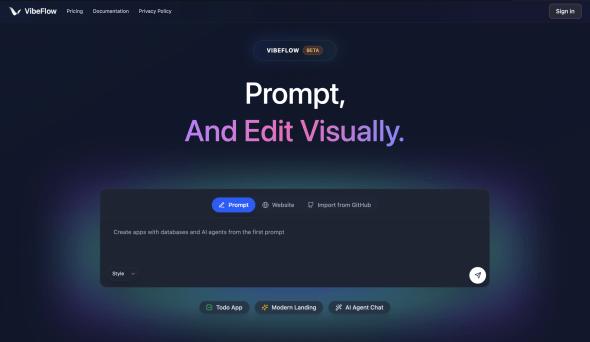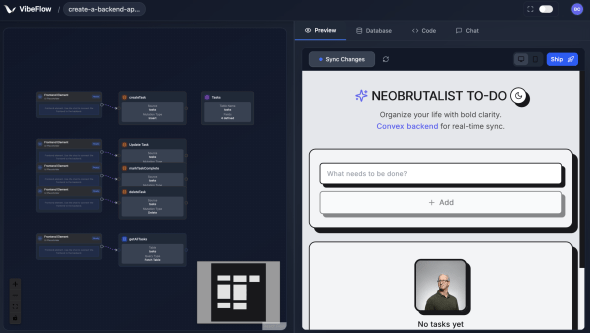VibeFlow: The Ultimate AI Tool for Modern Developers
VibeFlow is an AI-powered, spec-driven platform designed to accelerate the software development lifecycle. Founded in 2025 by Alessia Paccagnella and Elia Saquand, the tool launched in a beta phase and is engineered to translate product requirements directly into functional code. It primarily achieves this by using AI agents that understand development tasks, manage documentation, and maintain context across a project’s codebase. The platform is particularly useful for developers and software teams looking to streamline their workflow and reduce the friction between conceptualizing a feature and implementing it.
VibeFlow targets the common bottleneck in software development: the slow and often disconnected process of manual backend coding. Its core value proposition is its ability to generate full-stack applications, with a strong emphasis on a visual, node-based backend builder. This approach disrupts traditional development by offering a transparent, low-code environment where users can see, modify, and understand the logic being created. Instead of being a “black box,” the tool provides editable TypeScript code, empowering developers while significantly speeding up the creation of APIs and application logic.
Best Use Cases for VibeFlow
- Entrepreneurs and Startups: For founders looking to build a Minimum Viable Product (MVP) quickly, VibeFlow is a game-changer. It can take a product specification and rapidly generate the foundational backend and frontend, drastically reducing the time and cost required to get a functional prototype to market for testing and validation.
- Frontend Developers: Frontend developers often need to wait for backend teams to build APIs. The tool empowers them to create their own backend logic through its intuitive visual editor, allowing for greater autonomy, faster project completion, and seamless integration between the client and server sides of an application.
- Product Managers: Product managers can use this AI website builder to translate user stories and feature requirements into working prototypes without deep coding knowledge. This helps in communicating ideas more effectively to development teams and stakeholders, ensuring that the final product aligns perfectly with the initial vision.
- Students and Educators: The platform serves as an excellent educational tool for learning backend development. Its visual, node-based interface demystifies complex concepts like API endpoints, data models, and business logic, providing a clear and interactive way for aspiring developers to understand how software is built.
Innovative Visual Builder: The node-based editor provides an incredibly intuitive way to create and manage complex backend logic without getting lost in code.
Full Code Transparency: Unlike many AI code generators, VibeFlow produces clean, editable TypeScript, giving developers full control and avoiding vendor lock-in.
Rapid Development Speed: The ability to go from a natural language prompt to a deployed full-stack application dramatically accelerates the prototyping and development process.
Excellent Value: The free Starter plan is generous for small projects, and the $10/month Pro plan is highly affordable for the power it offers.
Seamless GitHub Integration: Built-in synchronization with GitHub repositories makes version control and automated deployment straightforward.
Context-Aware AI Agents: The tool's ability to maintain context across documents and tasks helps ensure consistency and reduces repetitive work.
Responsive Development Team: User feedback indicates the team is actively engaged and quick to implement improvements and fix bugs.
Beta Stage Instability: As a tool in beta, some users have encountered occasional bugs and functional errors during use.
Constrained Free Tier: The Starter plan is limited to a single code-aware agent project, which may be restrictive for users wanting to explore multiple ideas.
Niche Integrations Missing: While GitHub integration is key, the platform could benefit from a wider range of integrations with other developer tools and services.
-
Visual Backend Builder: Create, view, and manage backend logic, APIs, and data models using a drag-and-drop, node-based interface.
-
Full-Stack Application Generation: Transforms natural language prompts into complete, deployable web applications with both frontend and backend components.
-
AI-Powered Task Management: Employs AI agents to manage and execute development tasks based on high-level specifications.
-
Spec-Driven Development: Uses product requirements and documentation as the source of truth to guide the AI in the development process.
-
Context Portability: Allows users to access their project tasks, documents, and context across multiple development environments, including VSCode and Cursor.
-
GitHub Integration: Automatically syncs with GitHub repositories for version control and streamlined CI/CD pipelines.
-
Editable Code Output: Generates clean, human-readable TypeScript that developers can export and modify as needed.
-
Workflow Automation: The Pro plan offers full workflow automation to further streamline development and deployment processes.
-
Code-Aware AI Agents: AI agents have the ability to understand the context of the existing codebase when performing tasks.
 VibeFlow Homepage
VibeFlow Homepage
 Web App From VibeFlow
Web App From VibeFlow
Frequently Asked Questions
What is VibeFlow?
VibeFlow is a spec-driven task management platform that uses AI agents and a visual editor to build and manage full-stack web applications.
Who should use VibeFlow?
VibeFlow is designed for developers, software teams, entrepreneurs, and product managers who want to accelerate the software development process.
Is VibeFlow free to use?
The tool offers a free Starter Plan that includes one code-aware agent project and basic analytics. Paid plans are available for more advanced features.
What programming language does VibeFlow use?
VibeFlow generates editable code in TypeScript, a popular and modern language for web development.
Can I export my code from VibeFlow?
Yes, VibeFlow provides full code transparency, allowing you to export the generated code and use it in any development environment.
Tech Pilot’s Verdict on VibeFlow
I’ve spent a significant amount of time evaluating AI development tools, and it’s rare to find one that strikes a truly effective balance between AI-driven automation and developer control. My goal in testing VibeFlow was to determine if its visual, spec-driven approach could genuinely accelerate a real-world development workflow without becoming an obstructive “black box.”
First, I tested the core “Prompt to Backend” feature. I gave it a simple but practical task: “Create a backend API for a to-do list application. It needs endpoints to get all tasks, create a new task, and mark a task as complete.” Within minutes, this AI website builder generated not just the API endpoints but also a visual representation of the logic in its node-based editor. The real magic happened when I clicked on a node and saw the clean, well-structured TypeScript it had produced. It was immediately understandable and, more importantly, editable. This transparency is a massive win.
Next, I decided to push the visual editor. I wanted to modify the API to add a “priority” field to each task. Instead of writing code, I dragged a new input into the data model on the visual canvas and connected it to the “create new task” logic. The tool instantly updated the underlying TypeScript code to reflect the change. This workflow felt incredibly fluid and intuitive. It demonstrated that VibeFlow isn’t just a one-time code generator; it’s a dynamic development environment that keeps the visual layer and the code layer perfectly in sync.
From a value perspective, the pricing is highly competitive. The free tier is sufficient for exploring the platform’s capabilities, and the $20/month plan is a very small price to pay for the amount of development time it can save. The learning curve is also gentle, especially for anyone with a basic understanding of API structures. It successfully abstracts away the boilerplate without hiding the essential logic.
Top Alternatives to VibeFlow
-
Lovable: Lovable also uses AI to build applications but takes a chat-based, conversational approach. It excels at generating React and Supabase applications for non-technical founders who need an MVP extremely quickly. However, VibeFlow offers far more control and transparency through its visual editor and editable code output, making it a better choice for developers who want to customize and scale their applications.
-
Firebase Studio: As a full-code, browser-based IDE from Google, Firebase Studio is a powerhouse for professional developers already in the Google Cloud ecosystem. It offers more flexibility and power than VibeFlow but comes with a steeper learning curve and potential vendor lock-in. VibeFlow is the superior choice for rapid, targeted backend generation and prototyping, whereas Firebase Studio is built for developing complex, production-grade applications from the ground up.
-
Bubble.io: Bubble is a mature and powerful no-code website builder ai that allows users to build complex web apps without writing a single line of code. It’s an excellent choice for non-technical creators who want to manage everything visually. VibeFlow, in contrast, is a low-code tool. Its key advantage is that it generates a real, exportable codebase, freeing you from the platform and providing the foundation for unlimited custom development.
Final Verdict
VibeFlow is one of the most promising AI development tools I’ve reviewed this year. It successfully carves out a unique space between purely prompt-based generators and traditional coding. The combination of a visual backend builder with transparent, editable code output is a brilliant approach that empowers developers rather than replacing them. While its beta status means you might encounter a few rough edges, its core functionality is solid, and its potential to revolutionize backend development is undeniable.

